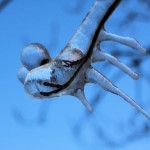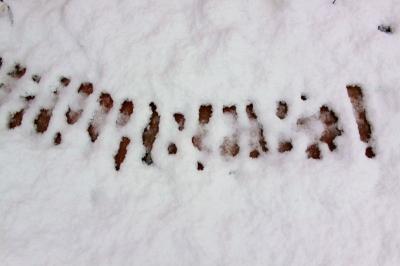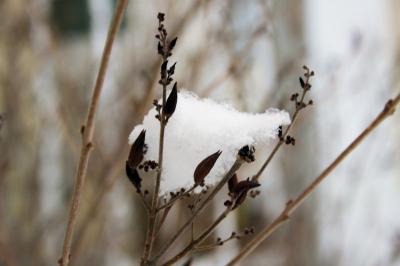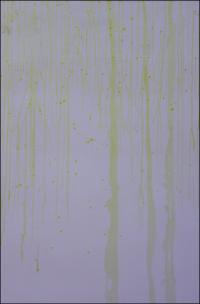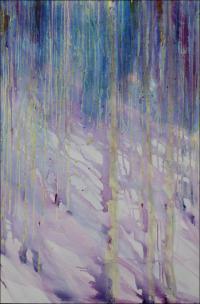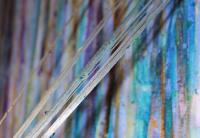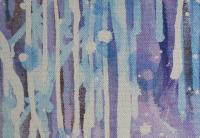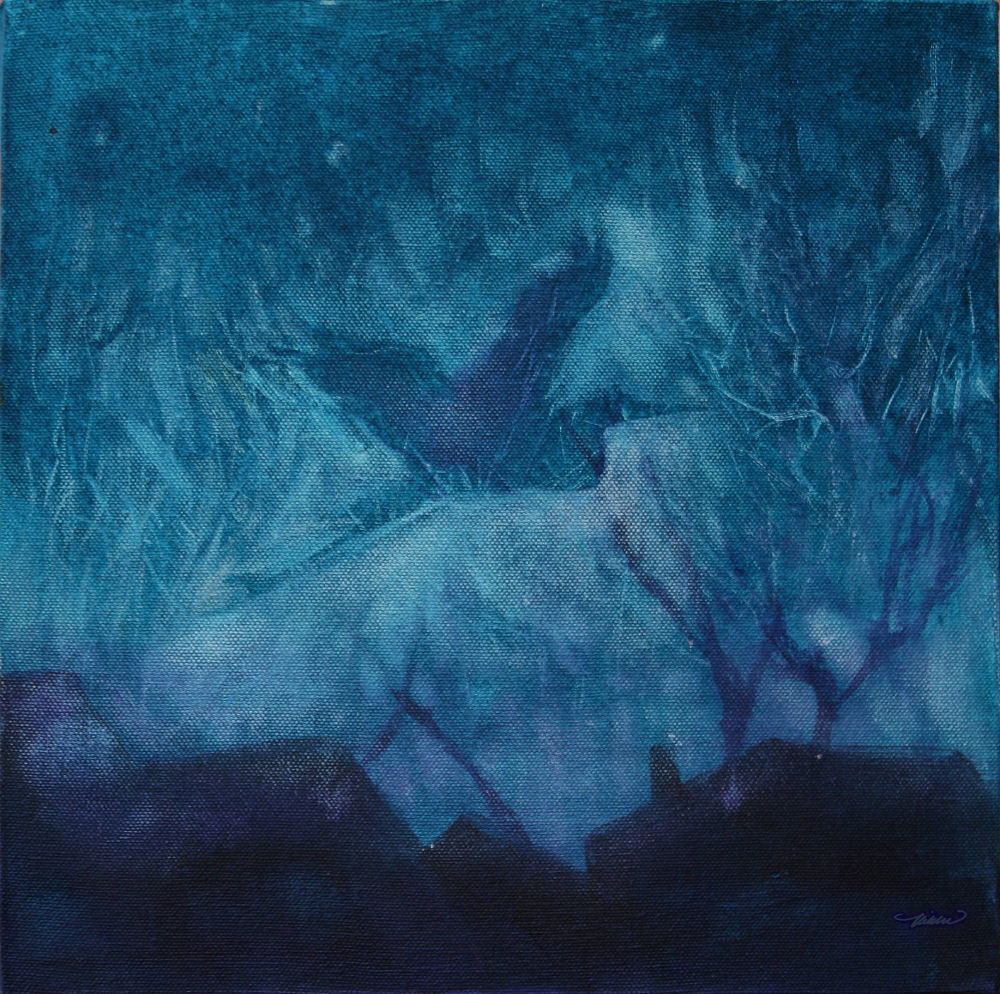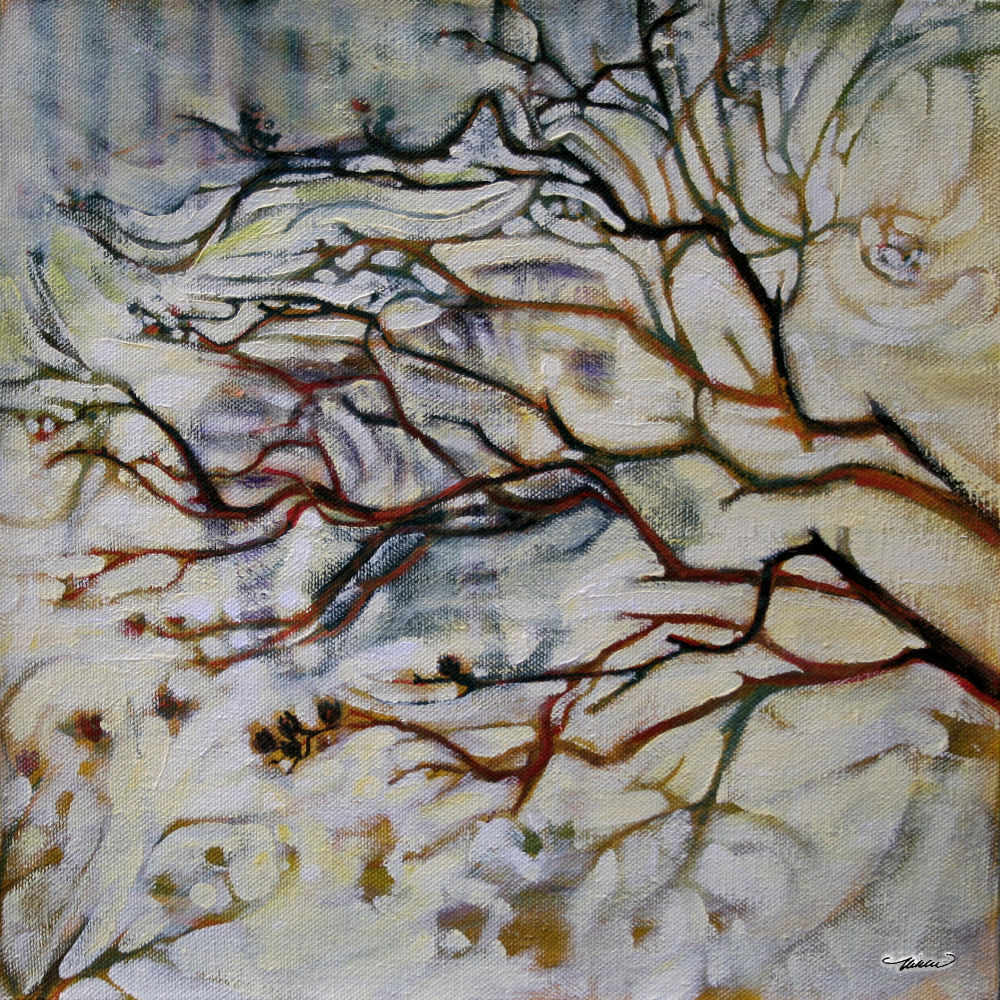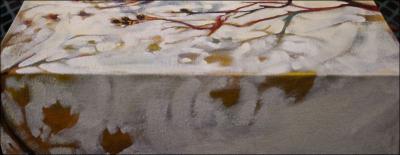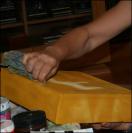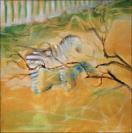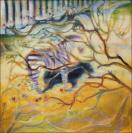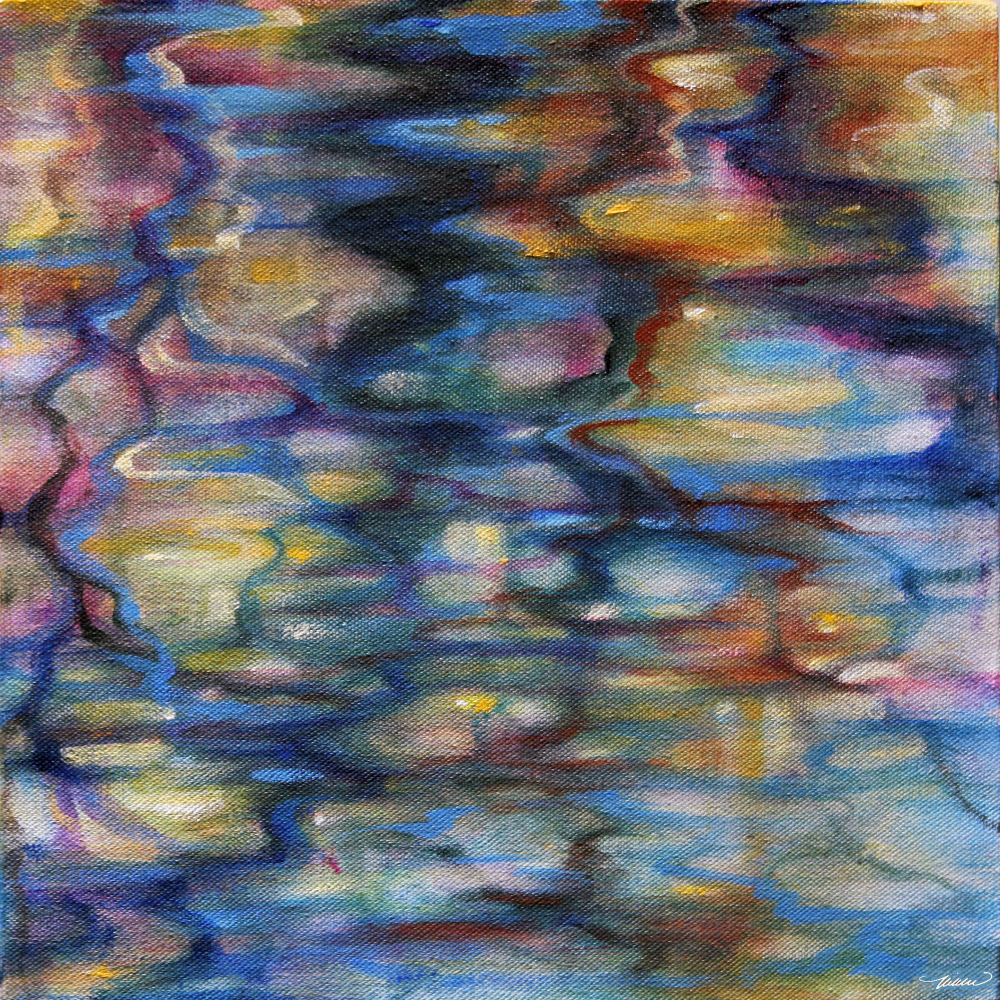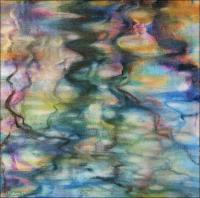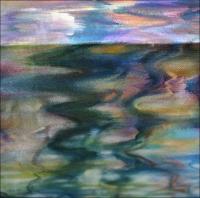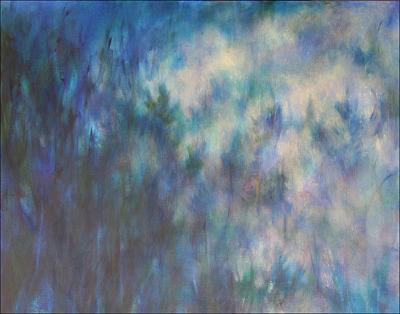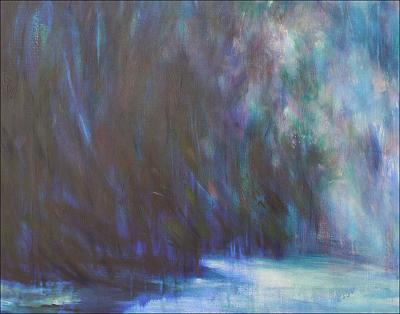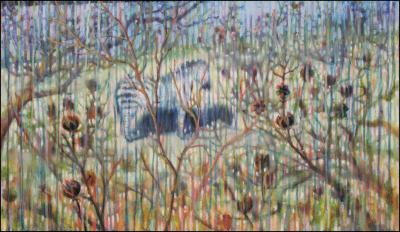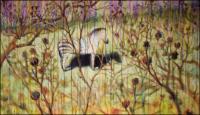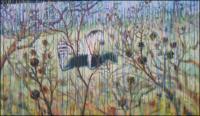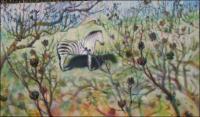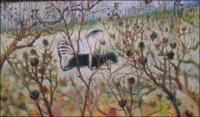Winter
« Previous Entries Next Entries »Five seconds of beauty
Thursday, February 10th, 2011
There are days when a falling leaf is just a falling leaf, but today one caught my eye as it floated down then caught an updraft, then flipping sideways and rolling over a few times, it seemed to be avoiding its final destination as long as it could. It was five seconds of beauty I will never forget!
I’m sure my friend and mentor, Jo Williams will not mind me passing along her note of a quote by Judith Hanson Lasater: “As many times a day as you can, find something to be grateful for because that will connect you with yourself, with others, and with the wider world. And we need to do this MOST when things are their most difficult in our lives. ”
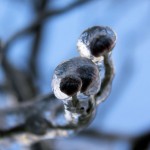 Maybe the leaves have fallen like that all season, but I was too busy grumbling about raking half of them from our neighbour’s yard. I’ve been too busy detailing the house inside and out, trying to get it listed as soon as possible. There have been issues this winter of solid ice in the eves-troughs, and having to chip away and melt trails with boiling water so the roof run-off would flow properly. I was too annoyed to notice the incredible phenomena on the other side of the house that were created by the very same problem.
Maybe the leaves have fallen like that all season, but I was too busy grumbling about raking half of them from our neighbour’s yard. I’ve been too busy detailing the house inside and out, trying to get it listed as soon as possible. There have been issues this winter of solid ice in the eves-troughs, and having to chip away and melt trails with boiling water so the roof run-off would flow properly. I was too annoyed to notice the incredible phenomena on the other side of the house that were created by the very same problem.
Left and above: alien-like forms were created when slow-melting ice dripped from the eaves-troughs onto shaded Dogwood branches.
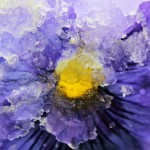 Before the snow and frigid temperatures last week, the pansies were finally filling in and gorgeous alongside the back yard fence. When winter came with a vengeance and would not let go, so did my view that, “Aww, the pansies are frozen!”, but yesterday,it changed to: “Awe! The pansies are frozen!”
Before the snow and frigid temperatures last week, the pansies were finally filling in and gorgeous alongside the back yard fence. When winter came with a vengeance and would not let go, so did my view that, “Aww, the pansies are frozen!”, but yesterday,it changed to: “Awe! The pansies are frozen!”
Thanks for sharing, Jo!
Translation
Thursday, February 11th, 2010
Translation: It’s snowing in Dallas today!
It snowed all day, huge Texas-sized flakes. Here, the snow melts on the warmth of the brick-work in the garden.
Happy Holidays
Friday, December 25th, 2009
Merry Christmas from Airdrie, Alberta
Snow on French Lilac
Check out the Alberta/Texas phone interview for a pull-out feature in today’s Denton Record Chronicle.
Learning to give critique
Wednesday, December 9th, 2009
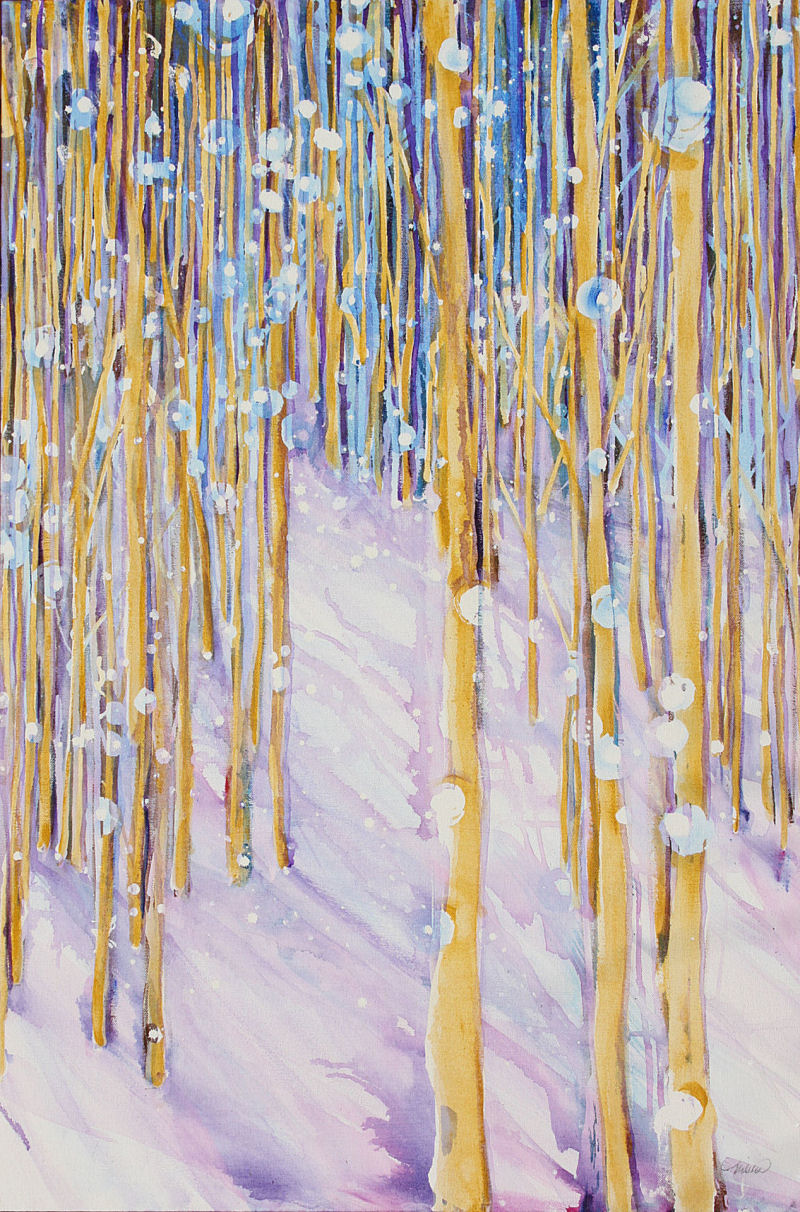 Creating Art and talking about are truly two different ways of seeing; the theory of right and left-brain thinking is matter of fact. As an Artist it takes some effort to “switch brains” and reflect on the processes and progress of work in order to accompany my Art with writing on this blog, so I’m really impressed with the mature quality of the critiques given by students at Olive Stevens Elementary School of paintings on their school Art blog every month.
Creating Art and talking about are truly two different ways of seeing; the theory of right and left-brain thinking is matter of fact. As an Artist it takes some effort to “switch brains” and reflect on the processes and progress of work in order to accompany my Art with writing on this blog, so I’m really impressed with the mature quality of the critiques given by students at Olive Stevens Elementary School of paintings on their school Art blog every month.
In collaboration with Oxide Gallery, the Denton school has started a blog where students – or anyone else actually – can give a critique of a different work of Art each month. This month the comments regard the recently finished Sounds of Silence, which is also at the gallery.
The Sound of Silence
Thursday, October 15th, 2009
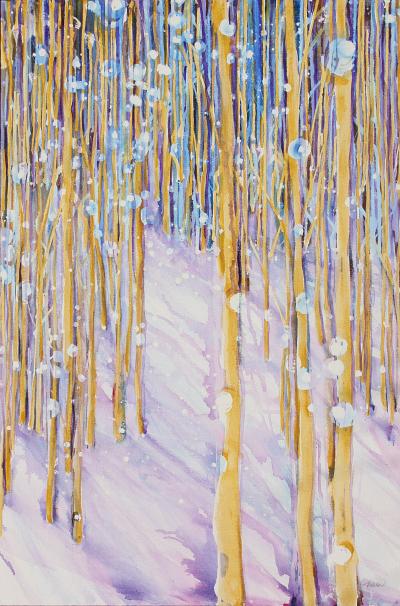
The Sound of Silence, 36H x 24W x 2D inches acrylics on canvas, wrapped sides painted, narrow frame – finished today. After a second application of mask medium only on the snowflakes this time, some unbleached titanium and yellow ochre brought color back to the trunks. Snowflake mask was then removed.
Oct 13th, above: Phase 01 and 02
Oct 14th, Phase 03 and 04: Mask medium removal, then highlighting snowflakes.
Neighborhood Heron
Thursday, March 19th, 2009
Neighborhood Heron, 11H x 11W x 3D inches acrylics on canvas, wrapped sides painted. Frame unnecessary. Hang on a wall or display on a flat surface. Signed on the side so as not to impose on the composition.
Sold but a similar piece can be recreated upon request. Please allow 7 days to paint before shipping.
Started with a base coat of very watered down translucent pthalos green mixed with cerulean blue. Spraying rubbing alcohol over a damp painted water-based surface then allowing it to dry without moving it will create starry, spotty textures. Salt shaken over wet paint allowed to dry, then wiped off with a dry cloth will produce similar effects.
Alcohol loosened up the entire surface of paint, so using fingernails under a damp smooth t-shirt cloth, I rubbed off areas to shape the heron and winter trees. This represents a super argument for the wingin’ it methods!
In college I took a pottery course for one semester, and the thing I remember most is the instructor saying how it’s a good idea to allow some of the raw characters of the materials we work with to remain and “speak” without trying to smooth over and perfect everything. She was of course referring to clay, but over the years I’ve found that it applies to many other mediums also. In Heron, the branches extend into the body of the bird, connecting it to its environment. The effect also does a subtle play on the motion of its flight too.
Showcased in the J. Mane Gallery’s Fins, Feathers and Fur 2020 exhibition.
Myrtle At The Zoo
Monday, March 9th, 2009
Myrtle At The Zoo – Crepe Myrtle branches and seedpods before pruning, February at the Fort Worth Zoo, Texas. 11H x 11W x 3D inches acrylics on canvas, wrapped sides painted. Signature is on the side, so one is superimposed here on the front. Hang on a wall or display on a flat surface.
Winter Reflections
Thursday, February 26th, 2009
Winter Reflections, winter in Coppell, TX, 11H x 11W x 3D inches acrylics on canvas, wrapped sides painted. Frame unnecessary. Hang on a wall or display on a flat surface. Signed on the side so as not to impose on the composition.
Approaching Winter
Sunday, December 7th, 2008
Approaching Winter finished today, 60H x 40W x 3D inches acrylics on canvas. More contemporary than my usual work, thought I’d try a new approach to painting…with more attention to editing rather than overworking. Shown in two detail images above, and full view shown in right thumbnail. Large paintings don’t show as well on computer screen, so there are two detail images that were sharpened 2X to reveal the actual texture as it is close up. Post-dated note: on exhibit at Oxide Gallery in Denton TX until February 28th, 2009.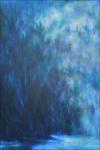
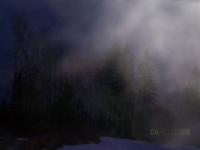
Dec. 6th: Colors mixed with matte medium: Ultramarine, Pthalos Blue, Prussian Blue, Cobalt Blue, Pthalos Green, Sap Green, Unbleached Titatium, Alizarin Crimson and Cadmium Red Deep, Mars Black (rarely use black). This morning I scrubbed and washed away a lot of paint in areas then reapplied more. Trying to stay with the less is more principle. Hope to wrap this one up by the end of the weekend if not before.
Dec. 5th: Stage 1, first coat of Ultramarine Blue and matte medium, very watered down, then applied thick in places. Inspired by photos taken by my good friend Ray Muskego in my home town, Cold Lake, Alberta during sunrise December 4th as misty fog drifted off the lake.
Myrtle At The Zoo, March 10 – April 2
Wednesday, April 2nd, 2008
Myrtle at the Zoo, Crepe Myrtle branches and seed-pods, 20H x 34W x 2D inches acrylics on canvas study, sides painted. Posts here go back to the start of work, sharing the process.
I’ve learned a lot and enjoyed playing with different ideas. It’s been interesting teetering back and forth between frustration and fun, but sometimes that’s what painting is all about. There’s been such a tension over this one as with no other painting, where the urge to throw it away is pitted against the determination to see what could happen. I still like a lot of things in it, such as the technique of dripping paint down the front that I’ve tried in previous paintings. Dripping re-energized the painting and me, and took the work in unexpected directions.
April 1st: 1. dripped violet across the top and deep yellow from the bottom. This move brings about a new set of problems that may lead the way to what I’m searching for; could be that recovery is impossible 2. Later notes after one days of work, Apr.1st: I like where the drips made me go…sometimes you’ve gotta take a leap.
March 27th – 30th The zebra is too prominent no matter what I try to blur it into the background, so more branches have been added to the foreground.
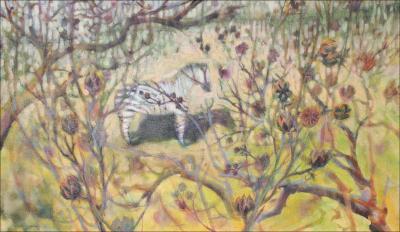
March 20th – 26th: After another few days of remapping, I like the direction it’s taking with the larger Myrtle seed-pods in the foreground…hardly touched the zebra, except before starting today, scrubbed and washed off a lot of the surface and concentrated mainly on re-working the whole composition.
Art in general, no matter what the media, has us confront varying emotions while we work, pleasant and unpleasant. If the piece is taking longer than anticipated, any self-expectations that mount don’t help the progress at all. There are also echos of things other Artists say, like “if it’s taking too long, trash it and start over”. That one always puzzles me – why tell someone to quit? How about searching for all that the work might possibly become? Fear of ruining work that’s already accomplished can hold us back from throwing our whole selves into it, bringing it to a new level.
It seems that so much fuss is made about paintings that are whipped off in a day. While the method of finishing work quickly is great, this is not the ideal for every painter. Most paintings do have a lot of life and zing after only one day of work and sometimes it’s best to leave them that way. Some Art is best left as “pure”, responsive, raw… and some work begs to be analyzed and dissected, perhaps to the death of the piece and having nothing to show for the labor.
Each artist knows if each painting at the end of the day has potential to become something more, and the decision to stay or to search is different with each and every piece. I say don’t give up if a painting takes too long to come to fruition.
March 15th – Freestyle brushstrokes have livened work up a little since the last post. Intentions are for the painting to be more about the Myrtle than the zebra, but the zebra is key to determining the rhythm of the whole composition. The biggest challenge is that the zebra is such a striking subject alone, and competes for importance with the branches. Color is a huge issue also, because the ground is dry and bright during winter, but so is the zebra. This is why I have yellow tones in the ground, and gradually am adding darker values, playing with colors throughout the painting process.
Every aspect is gradually worked through as painting progresses; no definite decisions made until the final day. If/when work finally succeeds, all the stages of color transitions show through in bits and pieces across the canvas, contributing to the final color and depth impressions. It’s really the process of change in a painting that’s most enjoyable and educational. Every stage is photographed or scanned, and the process can be evaluated after it’s finished.
– am finding it hard to maintain a balance of weight on the right and left sides beside such strong tones in that fur…I may add is a couple of unusually large detailed seed-pods in the foreground to take the eyes’ attention away from the zebra at first glance. I keep playing with colors, patterns, brushstrokes, scratching/removal of paint and anything I can think, still aware that the painting needs more depth.
March 10th – striving for an accurate portrayal of Crepe Myrtle branches in winter, and except for a few detailed seed-pods in the foreground, an overall abstract representation more than realism. The zebra is purposely off-center in an attempt to allow more space for the main subject. Establishing the composition is always priority over accurate colors at first, which of course are to be considered but like other details are left until the final day of completion.
« Previous Entries Next Entries »

